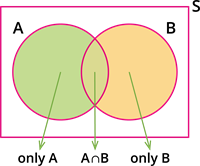UPSKILL MATH PLUS
Learn Mathematics through our AI based learning portal with the support of our Academic Experts!
Learn moreStatement:
(i) If A and B are any two non mutually exclusive events then:
P(A \cup B) = P(A) + P(B) - P(A \cap B)
(ii) If A, Band C are any three non mutually exclusive events then:
P(A \cup B \cup C) = P(A) + P(B) + P(C) - P(A \cap B) - P(B \cap C) - P(A \cap C) + P(A \cap B \cap C)
Proof of the theorem:
Statement (i):
Let A and B be any two events of a random experiment.
Let S be its sample space.

From the Venn diagram, we observe that the events only A, only B and A \cap B are mutually exclusive.
The union of these three events is A \cup B.
Therefore, P(A \cup B) = P(\text{only }A) + P(A \cap B) + P(\text{only }B).
(i) P(A \cap \overline B) = P(\text{only A}) = P(A) - P(A \cap B)
(ii) P(\overline A \cap B) = P(\text{only B}) = P(B) - P(A \cap B)
\Rightarrow P(A \cup B) = \left[P(A) - P(A \cap B)\right] + P(A \cap B) + \left[P(B) - P(A \cap B)\right]
\Rightarrow P(A \cup B) = P(A) + P(B) - P(A \cap B)
Hence, the proof.
Statement (ii):
Let A, B and C be any three events of a random experiment.
Let S be its sample space.
Let D = B \cup C.
Thus, P(A \cup B \cup C) = P(A \cup D).
\Rightarrow P(A \cup B \cup C) = P(A) + P(D) - P(A \cap D) [By statement (i)]
= P(A) + P(B \cup C) - P\left[A \cap (B \cup C)\right]
= P(A) + \left[P(B) + P(C) - P(B \cap C)\right] - P\left[(A \cap B) \cup (A \cap C)\right]
= P(A) + P(B) + P(C) - P(B \cap C) - \left[P(A \cap B) + P(A \cap C) - P\left((A \cap B) \cap (A \cap C)\right)\right]
= P(A) + P(B) + P(C) - P(B \cap C) - P(A \cap B) - P(A \cap C) + P(A \cap B \cap C)
Therefore,
P(A \cup B \cup C) = P(A) + P(B) + P(C) - P(A \cap B) - P(B \cap C) - P(A \cap C) + P(A \cap B \cap C).
Hence, the proof.